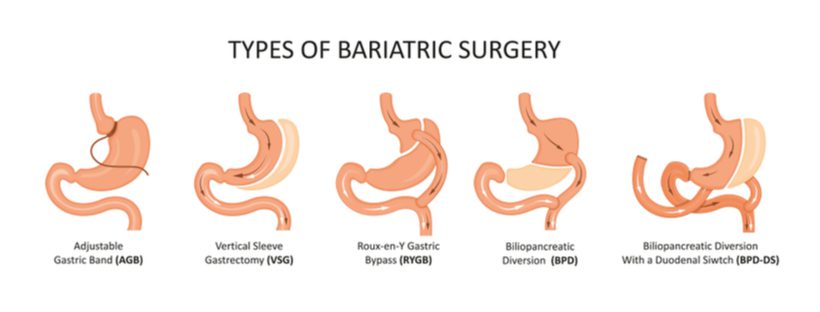What is Bariatric Surgery?
Bariatric surgery encompasses several procedures that help people achieve long-term weight loss. These procedures promote weight loss by altering the digestive system to reduce the amount of food you can consume and limit the number of calories your body absorbs. Bariatric procedures are performed laparoscopically, meaning they are minimally invasive. Because the incisions are small, patients experience less pain and a faster recovery period after surgery.
Obesity affects several aspects of day-to-day life. If you’re carrying a significant amount of excess weight, you may suffer from other health conditions such as type 2 diabetes, high blood pressure, sleep apnea, and more. Feeling comfortable or confident can be a daily challenge.
Why is it so Hard to Lose Weight?
It’s incredibly frustrating when eating a healthy diet and exercising regularly don’t produce results. Part of the problem is that your body is working against you. When you try to restrict your calories, your body thinks you are starving. It responds by slowing your metabolism to hold onto fat for longer and flooding your system with ‘hunger hormones’ to trigger food-seeking behavior. Excess fat cells also desensitize your brain to the hormones that reduce your appetite.

Another hurdle is that obesity reduces your calorie-burning capability. Fat cells burn calories much slower than lean muscle. Compounding the issue, exercise is often much harder for overweight individuals. Joint pain and mobility issues restrict how much you can exercise and the types of exercises you can perform if you’re obese.
You don’t have to resign yourself to a lifelong struggle with obesity. Request an appointment to learn if you’re a good candidate for weight loss surgery.
Types of Bariatric Surgery
How bariatric surgery promotes weight loss depends on the type of procedure. Weight loss surgery either reduces the amount of food your stomach can hold, limits your body’s ability to absorb calories, or uses a combination of the two. These are the common types of bariatric surgery
- Gastric Plication
- Gastric Balloon Surgery
- Gastric Bypass Surgery
- Sleeve Gastrectomy Surgery
- Lap Band Surgery
Gastric Plication
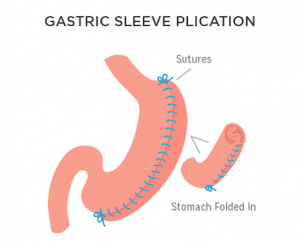
Plication surgery is a newer weight loss procedure. Dr. Waldrep has been performing plication surgery , which he calls the WRAP (Weight Reduction Assistance Procedure) since 2009. The WRAP differs from other bariatric procedures in several ways. It does not rearrange, remove, or cut any part of your intestines. It also doesn’t leave a device inside your body. As a result, patients who elect for the WRAP can also go home the same day of surgery.
The WRAP works by folding the stomach in on itself and securing the new shape with sutures. This procedure reduces the amount of space available in your stomach for food, decreases your stomach’s ability to stretch to take in more food, and reduces how much food you need to eat to feel full. It also may be possible to reverse the procedure should you so desire in the future.
Gastric Balloon Surgery
This procedure isn’t an actual surgery, which appeals to patients who want as minimally invasive a procedure as possible. Gastric ballooning is performed under twilight sedation and takes around 20 minutes. It’s a same-day procedure, so it does not require a hospital stay. The procedure involves placing an uninflated balloon inside the stomach and filling it with saline. Gastric balloons is used by some to kick-start their weight loss. Think of a Gastric Balloon as having the size, shape and weight of a grapefruit. The balloon works in several ways: by reducing how much space your stomach has for food; by reducing how fast the stomach might empty, allowing you to feel fuller after eating for longer periods of time; and by suppressing your appetite as it provides a sense of having recently eaten. The gastric balloon is removed after six months in a few minutes.
Gastric Bypass Surgery
Gastric bypass surgery combines the restrictive and malabsorptive approaches to weight loss. Gastric bypass surgery works by dividing the stomach into two segments: a smaller upper pouch and a larger lower pouch. Having a much smaller stomach reduces your appetite, how much you can eat at one time, and allows you to feel full on less food.
The second half of the surgery bypasses the larger stomach pouch with roughly five feet of the upper intestines. Your surgeon divides your intestines to connect your lower intestines to the smaller stomach pouch and your upper intestines to the larger stomach pouch. Because your digestive fluids and food do not mix in those five feet of intestine, your body has less intestine to efficiently absorb calories.
Many consider gastric bypass surgery as the most effective bariatric procedure. Most patients lose around 70% of their excess weight, and many experience significant improvement or resolution of their obesity-related health conditions. The surgery typically lasts 60-90 minutes and requires a 1-2-night stay in the hospital. Most patients are back to work by two weeks post-op.
Sleeve Gastrectomy Surgery
Sleeve gastrectomy surgery involves removing the left two-thirds of the stomach, which is the part that stretches the most and expands to accommodate a significant amount of food. By removing it, your stomach takes on a tube-like or ‘sleeve’ shape and doesn’t stretch as easily. You have less space for food, and you don’t need to eat as much food as you did pre-surgery to feel full.
Unlike gastric bypass surgery, sleeve gastrectomy leaves the intestines untouched. Because it’s a less complicated procedure, the recovery time is shorter. Most patients stay in the hospital for one night after the surgery and are back to their usual activities within a week.
Lap Band Surgery
Lap band surgery is one of the less invasive weight loss procedures. It does not cut or remove parts of the stomach or intestines. Instead, it creates a small stomach pouch by narrowing a portion of the stomach. The result is an hourglass shape with a small upper pouch that can’t hold as much food and a bottleneck that slows how fast the upper pouch can empty into the lower pouch. This helps you feel full faster and for longer.
Lap band surgery is performed under general anesthesia, and you go home the same day of the procedure. The surgery takes about 30 minutes, and most people are back to their usual activities within a day or two. Recovery is rapid because the balloon that tightens the band is left loose in the beginning. Based on your weight loss, your surgeon can fill the band’s balloon with saline (“tighter”) or empty it (“looser”) in the office by accessing the lap band’s port under your skin as needed.
Am I a Good Candidate for Bariatric Surgery?
Your health profile is unique, and only your surgeon can determine if you’re eligible for bariatric surgery.
Are you ready to take the next step in your weight loss journey? Contact Dr. Waldrep to schedule a consultation appointment.
Bariatric Surgery Cost
Some insurance companies provide full or partial coverage for weight loss surgery, as they understand the long-term costs of obesity-related health issues. Some states require insurance companies to cover weight loss surgery so long as you meet their criteria for bariatric procedures. The total cost varies depending on several factors, such as the complexity of the procedure and how long you stay in the hospital, or even which particular facility where procedure is performed
Our office can assist you in confirming your insurance benefits, options, and financing.
Bariatric Surgery Diet
Bariatric surgery can help you achieve substantial weight loss, but works best when you maintain healthy lifestyle changes. Many surgeons recommend that bariatric patients start a healthy diet before surgery to ensure they’re as healthy as possible for the procedure. Your new diet has several phases as you progress through recovery. Our clinic will provide you with a specific outline of your diet phases and recommended liquids and food.
First Phase
You will have clear liquids such as juice and broth in the immediate recovery stage. The primary focus during this phase is seeing how many ounces your new anatomy can tolerate as you adjust to the bariatric diet.
Post-Op Through Week Two
You are still mostly on a liquid diet, but you will start consuming thicker liquids that are low fat, low sugar, and rich in protein. Some good options include low-calorie protein drinks, sugar-free pudding, low-fat cottage cheese, sugar-free nonfat yogurt, and cream of wheat. You can add powdered milk or protein powder to relevant foods as well to increase the protein content.
Weeks Two Through Four
You can begin incorporating purees and other soft foods at this stage. Take small bites and chew thoroughly. When incorporating something new, only take a couple of bites in a 20-minute window to ensure you’ll tolerate it. Good options include applesauce, pureed vegetables, mashed potatoes, scrambled eggs, noodles, canned fruits, and lean ground meat.
Week Four Through Eight
Your meals will still be small at this point. Remember to drink a glass of water between meals to prevent dehydration. Avoid drinking while eating, as the water can make you feel too full to eat your meal, or ‘wash’ calories downstream before you feel full.
Months Two Through Six
Your food options will normalize during this phase, but you can expect to feel full on less food.. Portion sizes are important; aim for ¼ cup for solid foods and ½ cup for liquids. You can still drink protein drinks if you need to, but you should aim to get as much of your protein as possible from solid foods.
Month 6 and Beyond
Your diet will look the same as the previous phase, but you can decrease your meals to three to four times per day with a snack. Avoid hard-to-digest foods if you don’t tolerate them well, such as raw vegetables, fruit with skin, popcorn, red meat, nuts, and bread.
Vitamins and Supplements
Your surgeon will recommend several vitamins and supplements to ensure you receive adequate nutrients. You’ll consume much less food than you did before surgery, which may make it difficult to get all the nutrients you need. Common vitamins and supplements include a daily multivitamin, iron, B12 or a B-complex, calcium, vitamin D, and zinc.
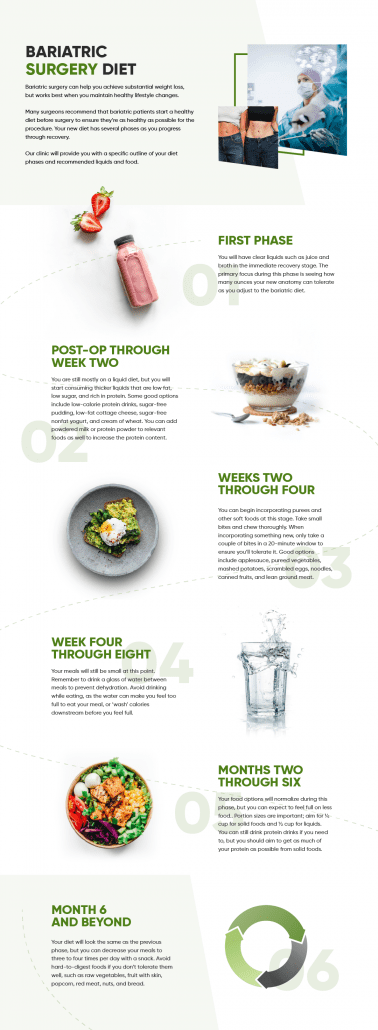
Bariatric Surgery Before and After Pictures
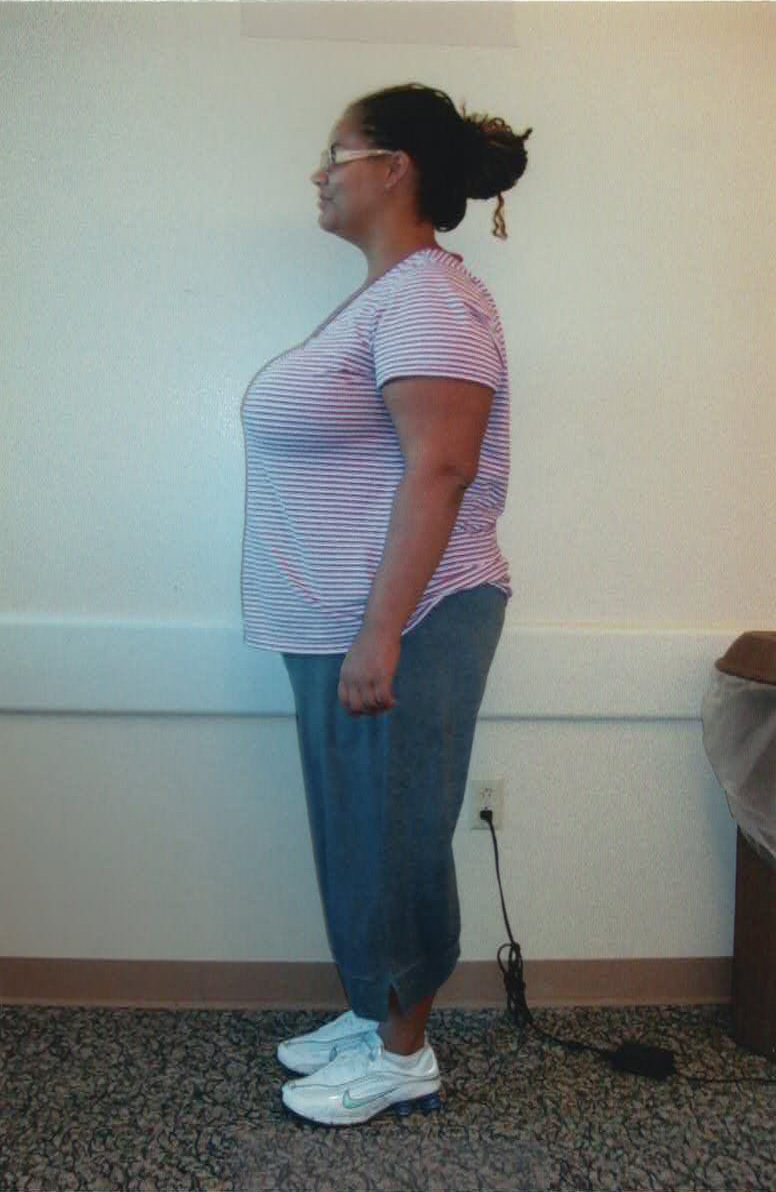

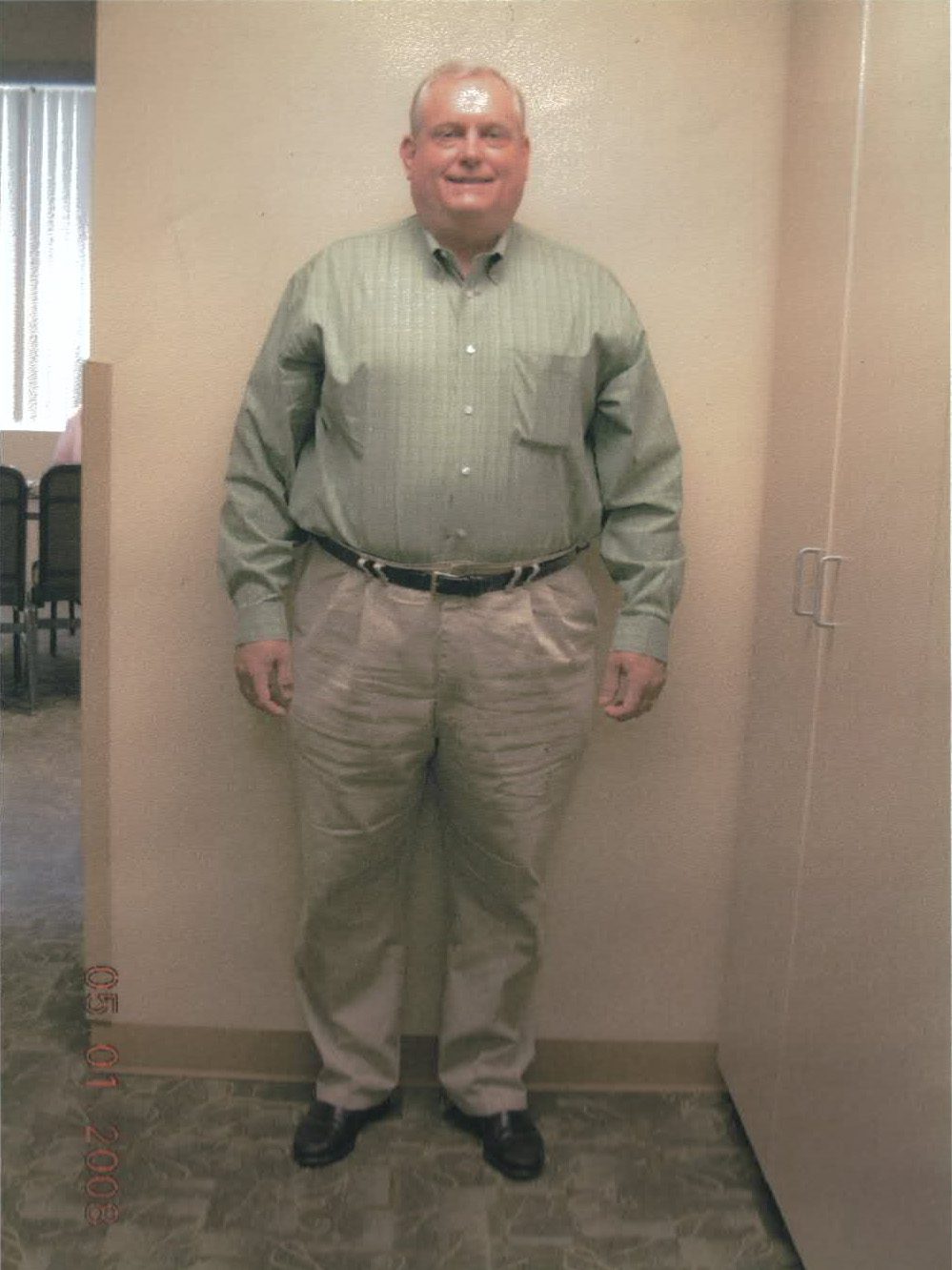
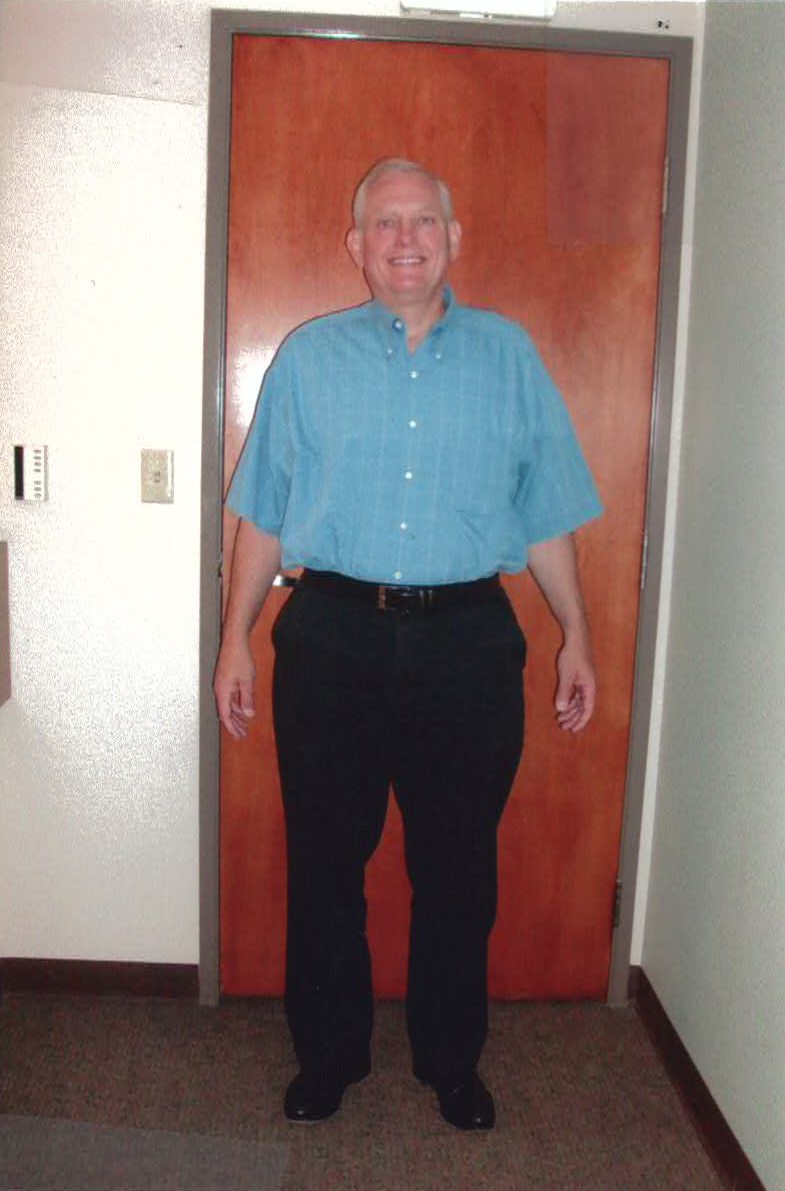

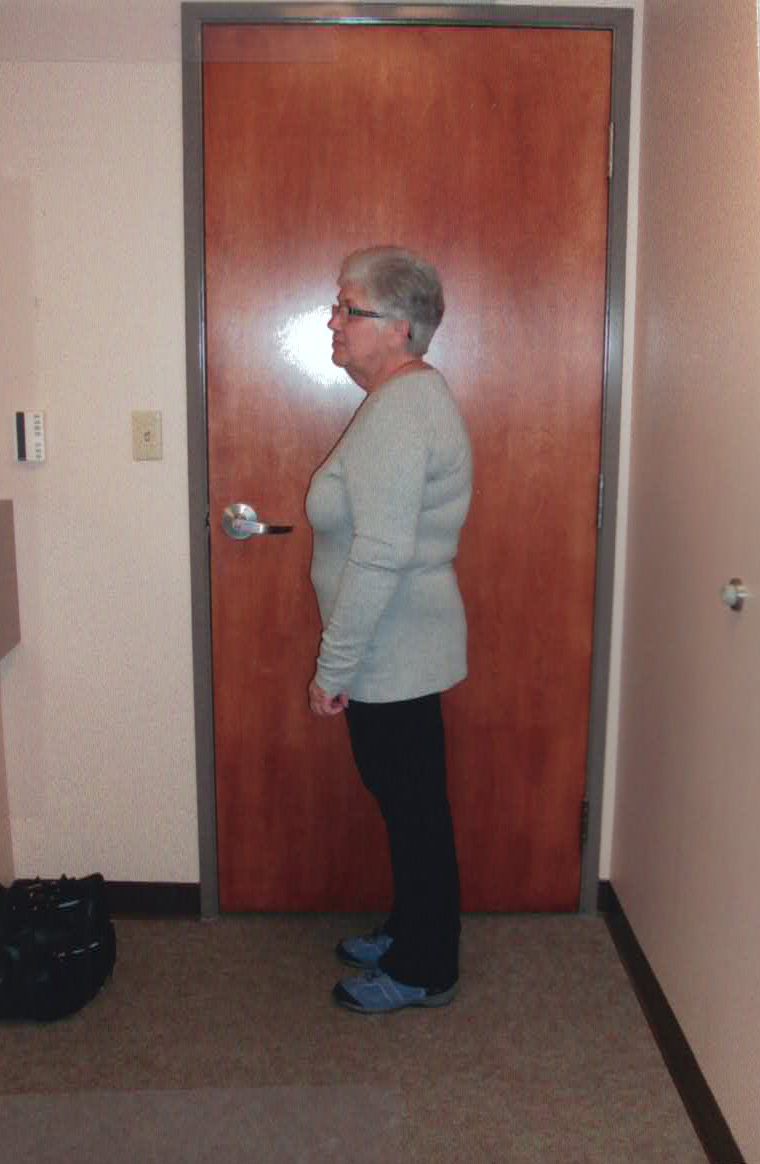
You don’t have to resign yourself to a lifelong struggle with obesity. Request an appointment to learn if you’re a good candidate for weight loss surgery.
Bariatric Surgery with Dr. Waldrep

Dr. Donald J Waldrep, MD FACS specializes in advanced, minimally invasive bariatric surgery. He has performed approximately 5,000 weight wellness procedures and an estimated 15,000 laparoscopic surgeries. Dr. Waldrep has contributed to the practice of bariatric surgery with his innovative stomach reshaping procedure known as “The WRAP.” Scientific paper on the WRAP here. Dr. Waldrep has helped thousands of patients with his advanced approach to weight loss surgery. You can arrange a personal appointment with Dr. Waldrep in Thousand Oaks or Beverly Hills.
Dr. Waldrep’s experience includes being a diplomat of the American College of Surgeons, a Fellow of the American College of Surgeons, a Fellow of the American Society for Metabolic & Bariatric Surgery, a Medical Director for a Bariatric Surgery Center of Excellence, and FDA investigator.
Related Resources for your Weight Loss Journey
Deciding to undergo bariatric surgery is a life-changing decision. Here are several resources to answer common questions and provide insight into life after weight loss surgery:
- Bariatric Surgery FAQs
- 7 Questions You Should Ask Your Bariatric Surgeon
- Top 10 Obesity-Related Health Risks You Need to Know
- What is the Average Recovery Time for Weight Loss Surgery?
- Why Are Vitamins So Important After Bariatric Surgery?
- Why is Exercise Essential After Bariatric Surgery?
Are you ready to take the next step in your weight loss journey? Contact Dr. Waldrep to schedule a consultation appointment.


